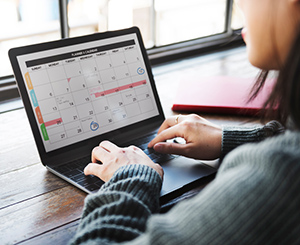Tips for Adults: Stop Procrastinating!

This is part of our Tips for Adults series. Check with us each week for more life Tips.
You may delay, but time will not, and lost time is never found again.
— attributed to Benjamin Franklin
It is easy to wholeheartedly agree with Mr. Franklin. And yet, it is just as easy to lose track of time doing something other than what’s on your to-do list.
Procrastination is a habit that we all fall back into. It happens when we feel tired, we want a break, or we think there’s plenty of time to do it later, anyway. For those of us affected by ADHD, the symptoms of the disorder can exaggerate procrastination behaviors. Distraction, impulsivity, and difficulties with time management all contribute to putting off until tomorrow what we should have handled today.
“When a person procrastinates, they pass the buck to their future self,” writes Shahram Heshmat, PhD, for Psychology Today. “Although some procrastinators claim that they work best under pressure, perhaps they also need the rush of a last-minute deadline to get started. The costs of procrastination are often considerable. Evidence suggests that the habit of leaving things until the last minute generally results in low-quality work performance and reduced well-being.”
Tips to handle procrastination
What can you do to be more proactive in your schedule? Try these tips:
Break apart the task and set “mini” goals on your calendar or day planner. Most tasks have multiple steps that can be listed and tackled individually. By setting aside time to do one small part, you can accomplish more smaller goals than waiting for a big chunk of time that might not arrive to do the entire task.
Work with your internal clock. When do you feel the most alert? What time of the day is better for you when it comes to doing housework or paperwork? Instead of fighting your own rhythms during the day, plan to use them. If you’re better at clearing the decks in the afternoon, plan to do work that requires concentration in the morning and use the afternoon to file, clean up and write to do lists for the following morning.
Use a timer. There’s a saying, “You can do anything for 15 minutes.” Confront the task at hand and set your timer for 10 or 15 minutes. Do just that task in one shot during that time and stop where you are when the timer goes off. You can then set the time for another go or switch to another task. Taking a group of tasks you’ve been putting off and giving them 10 or 15 minutes at a time in rotation can help you accomplish a lot more than forcing yourself to confront just one task until it’s “done” (or you give up on it).
Don’t go at it alone. Find a buddy, a co-worker, or a coach who can help you with accountability and support. Sometimes knowing that we have to report our progress to another person is the motivation we need to get our to-do list done.
Live by routine. Design a routine with automatic systems that helps you continue to move forward. Keep a written version of your routine with month-by-month, day-by-day, and hour-by-hour schedules in front of you. By automating your day, you can address many items that would otherwise end-up on your long-term to-do list. An example is a daily schedule that includes:
- Scheduled times for making coffee, checking email, filing papers, returning phone calls and project planning for the morning
- Blocks of time for specific projects in the afternoon
- A dedicated time for clearing away work and writing the next day’s project list
Get more tips
Looking for more?
- Organization and Time Management
- ADHD Experts Reveal Their Favorite Ways to Manage Procrastination
- FLYing Lessons
How do you handle the temptation to put off until tomorrow what you could do today?
We can all put off until tomorrow what we should have done today. But what can you do when this is a daily habit?
